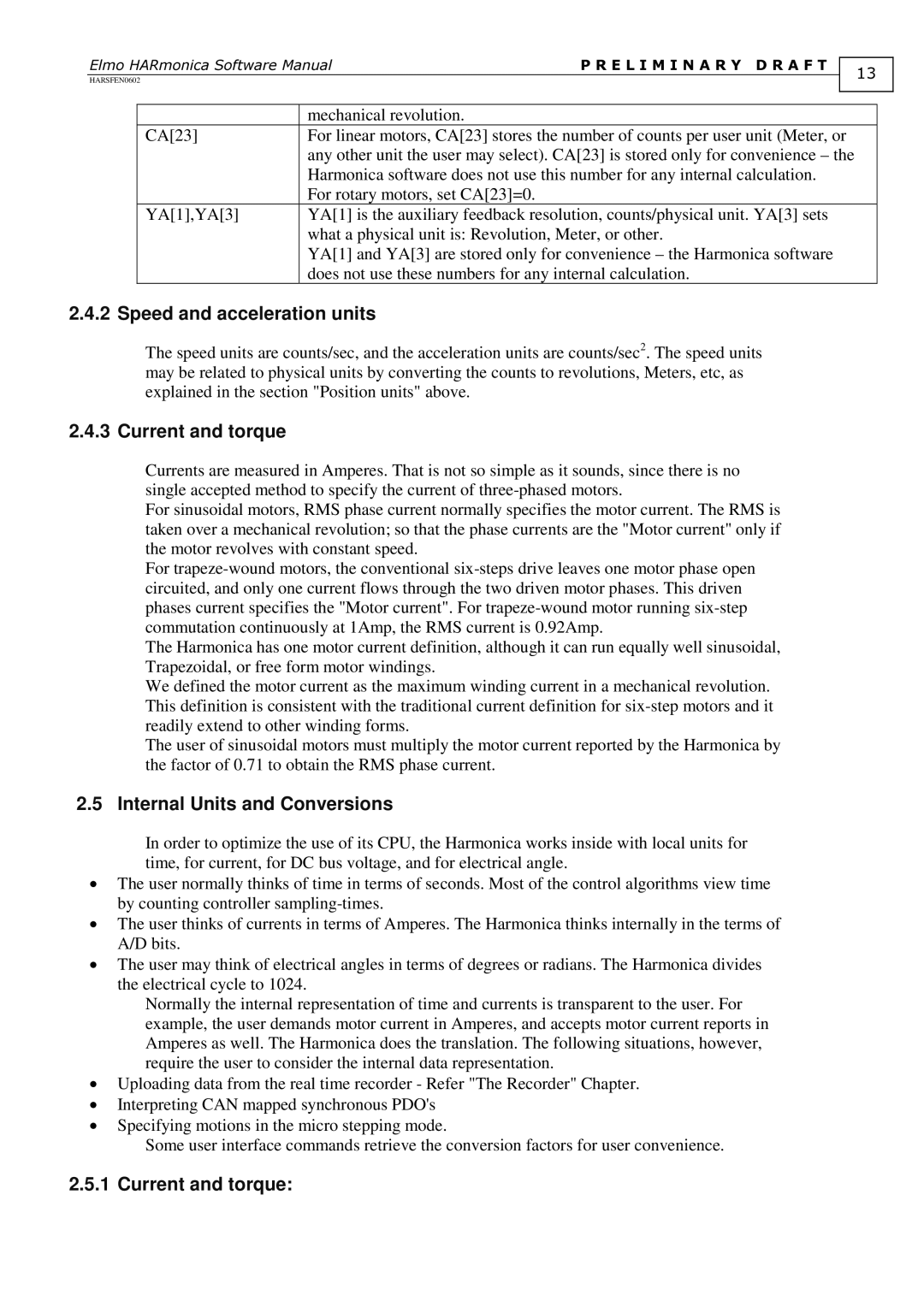|
|
|
|
|
|
|
|
HARSFEN0602ElmoHARmonicaSoftwareManual | PRELIMINARYDRAFT |
|
|
|
| ||
|
|
|
|
| 13 |
|
|
|
|
|
|
| |||
|
|
|
|
|
|
|
|
|
| mechanical revolution. |
|
|
|
|
|
| CA[23] | For linear motors, CA[23] stores the number of counts per user unit (Meter, or |
|
| |||
|
| any other unit the user may select). CA[23] is stored only for convenience – the |
|
| |||
|
| Harmonica software does not use this number for any internal calculation. |
|
| |||
|
| For rotary motors, set CA[23]=0. |
|
|
|
|
|
| YA[1],YA[3] | YA[1] is the auxiliary feedback resolution, counts/physical unit. YA[3] sets |
|
| |||
|
| what a physical unit is: Revolution, Meter, or other. |
|
| |||
|
| YA[1] and YA[3] are stored only for convenience – the Harmonica software |
|
| |||
|
| does not use these numbers for any internal calculation. |
|
| |||
2.4.2 Speed and acceleration units
The speed units are counts/sec, and the acceleration units are counts/sec2. The speed units may be related to physical units by converting the counts to revolutions, Meters, etc, as explained in the section "Position units" above.
2.4.3 Current and torque
Currents are measured in Amperes. That is not so simple as it sounds, since there is no single accepted method to specify the current of
For sinusoidal motors, RMS phase current normally specifies the motor current. The RMS is taken over a mechanical revolution; so that the phase currents are the "Motor current" only if the motor revolves with constant speed.
For
The Harmonica has one motor current definition, although it can run equally well sinusoidal, Trapezoidal, or free form motor windings.
We defined the motor current as the maximum winding current in a mechanical revolution. This definition is consistent with the traditional current definition for
The user of sinusoidal motors must multiply the motor current reported by the Harmonica by the factor of 0.71 to obtain the RMS phase current.
2.5 Internal Units and Conversions
In order to optimize the use of its CPU, the Harmonica works inside with local units for time, for current, for DC bus voltage, and for electrical angle.
The user normally thinks of time in terms of seconds. Most of the control algorithms view time by counting controller
The user thinks of currents in terms of Amperes. The Harmonica thinks internally in the terms of
•A/D bits.
The user may think of electrical angles in terms of degrees or radians. The Harmonica divides the electrical cycle to 1024.
Normally the internal representation of time and currents is transparent to the user. For example, the user demands motor current in Amperes, and accepts motor current reports in Amperes as well. The Harmonica does the translation. The following situations, however, require the user to consider the internal data representation.
Uploading data from the real time recorder - Refer "The Recorder" Chapter. Interpreting CAN mapped synchronous PDO's
•Specifying motions in the micro stepping mode.
Some user interface commands retrieve the conversion factors for user convenience.
2.5.1 Current and torque:
